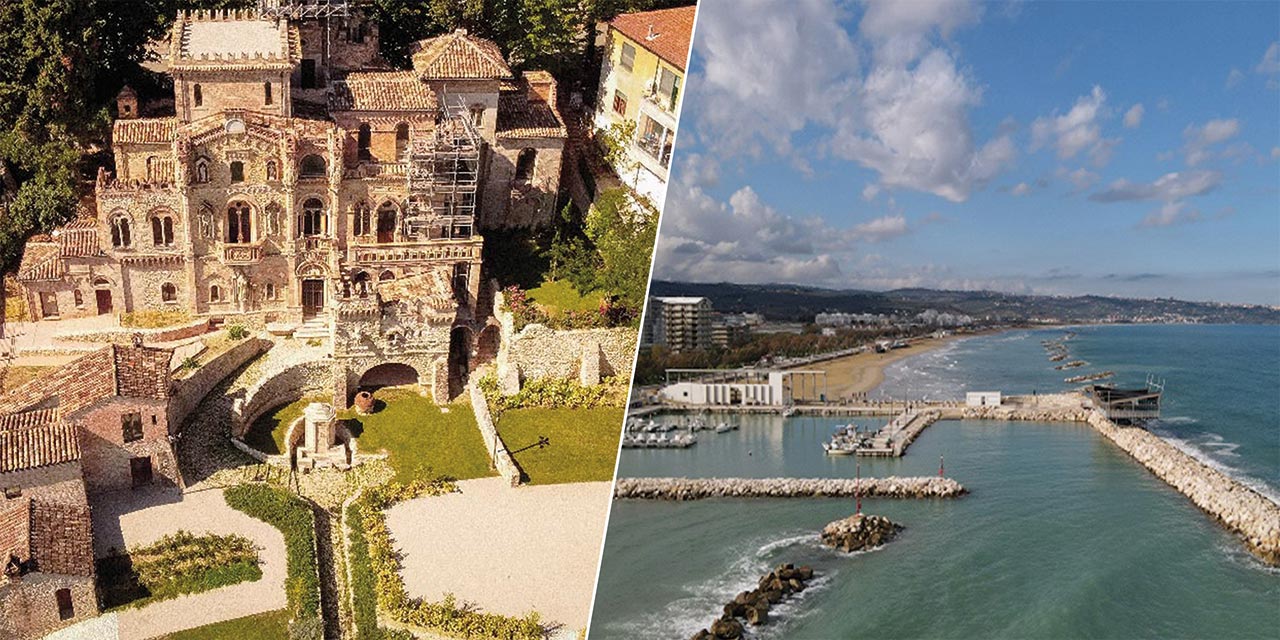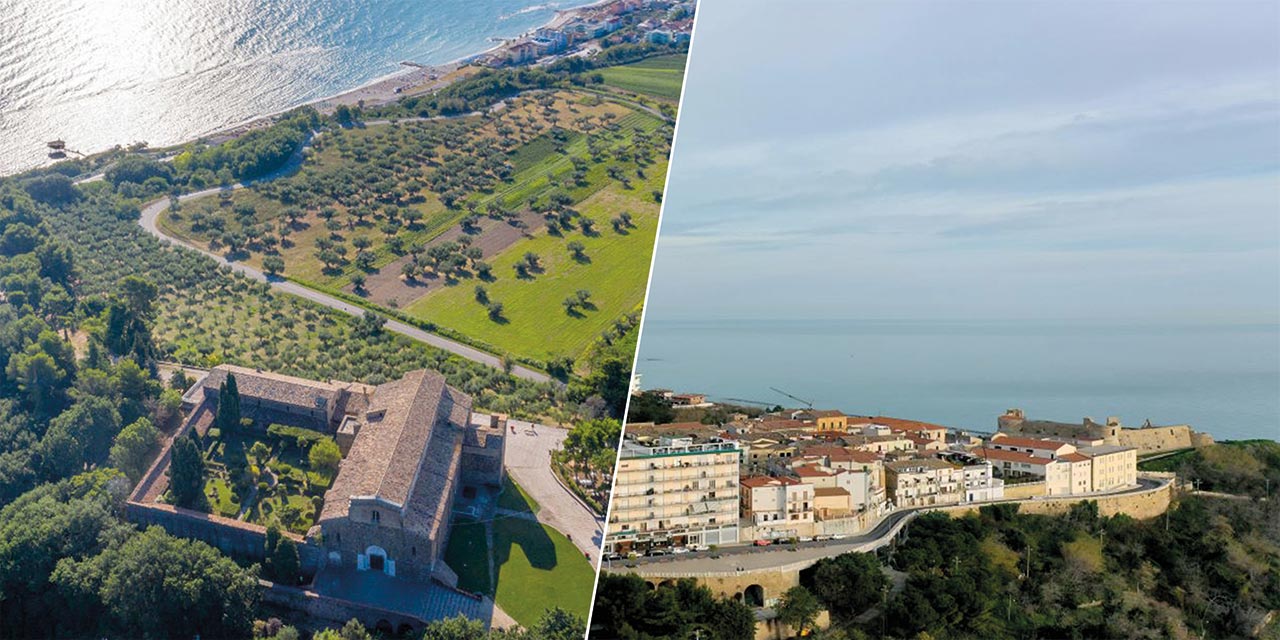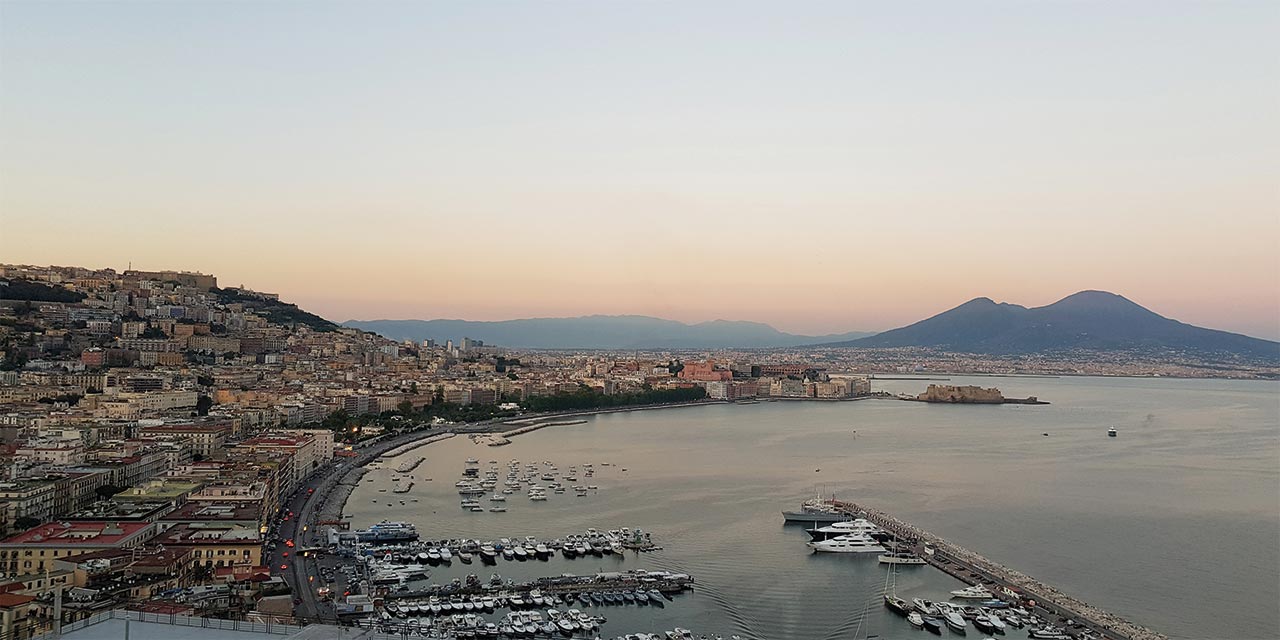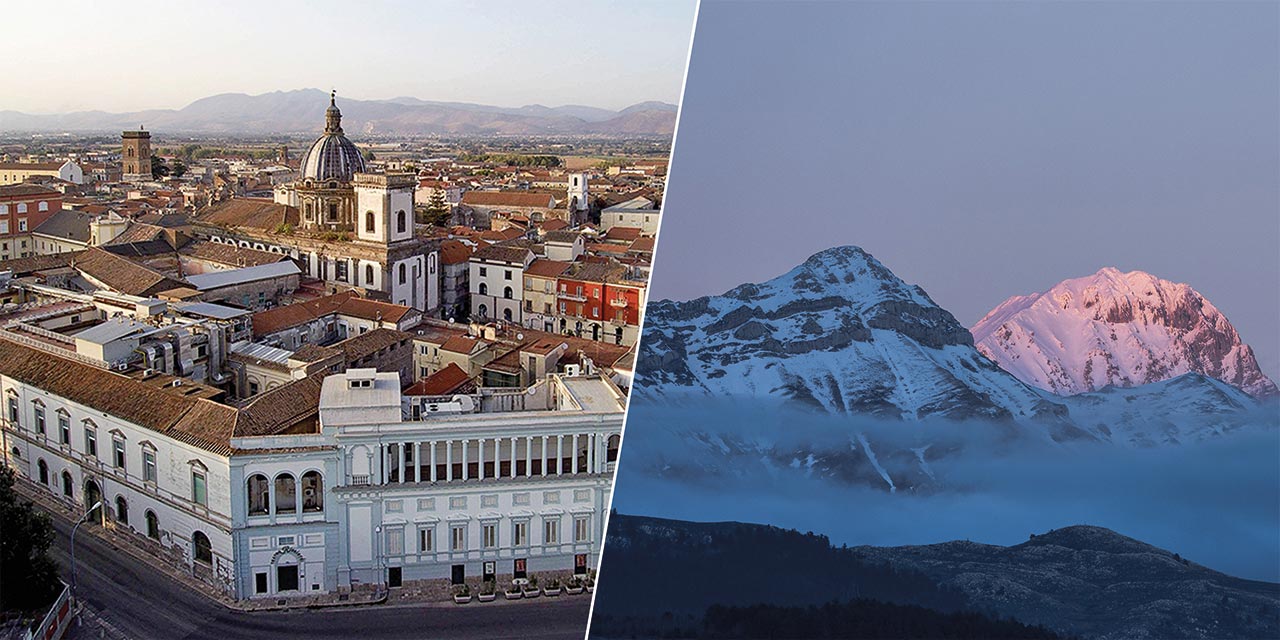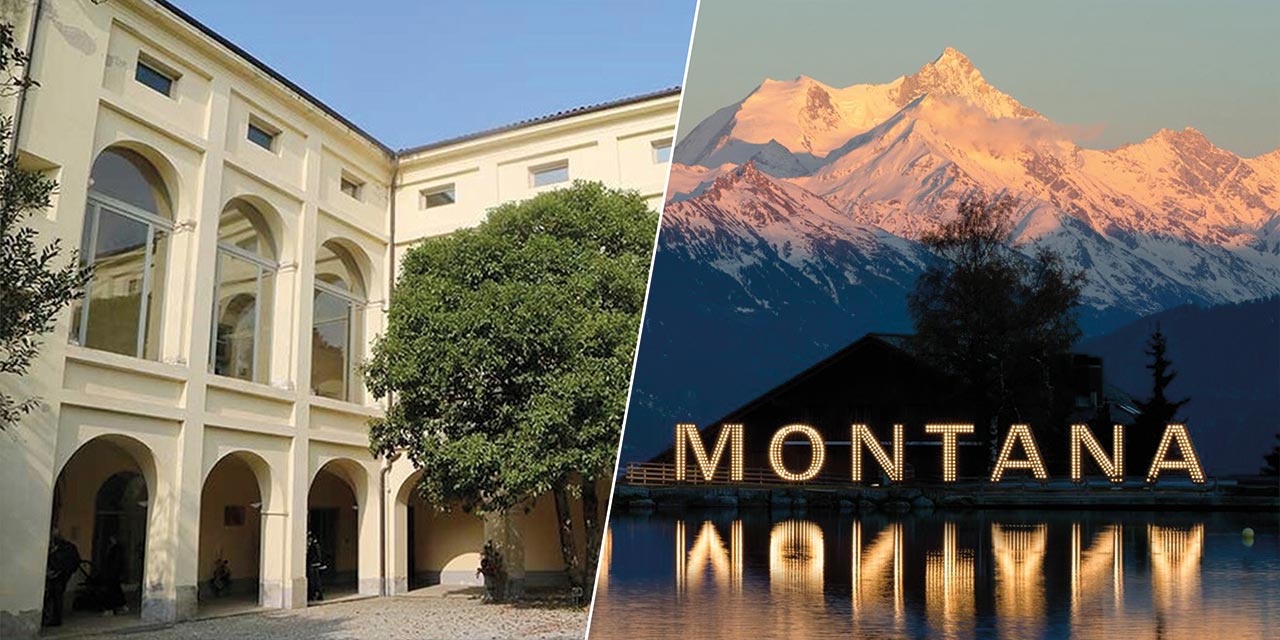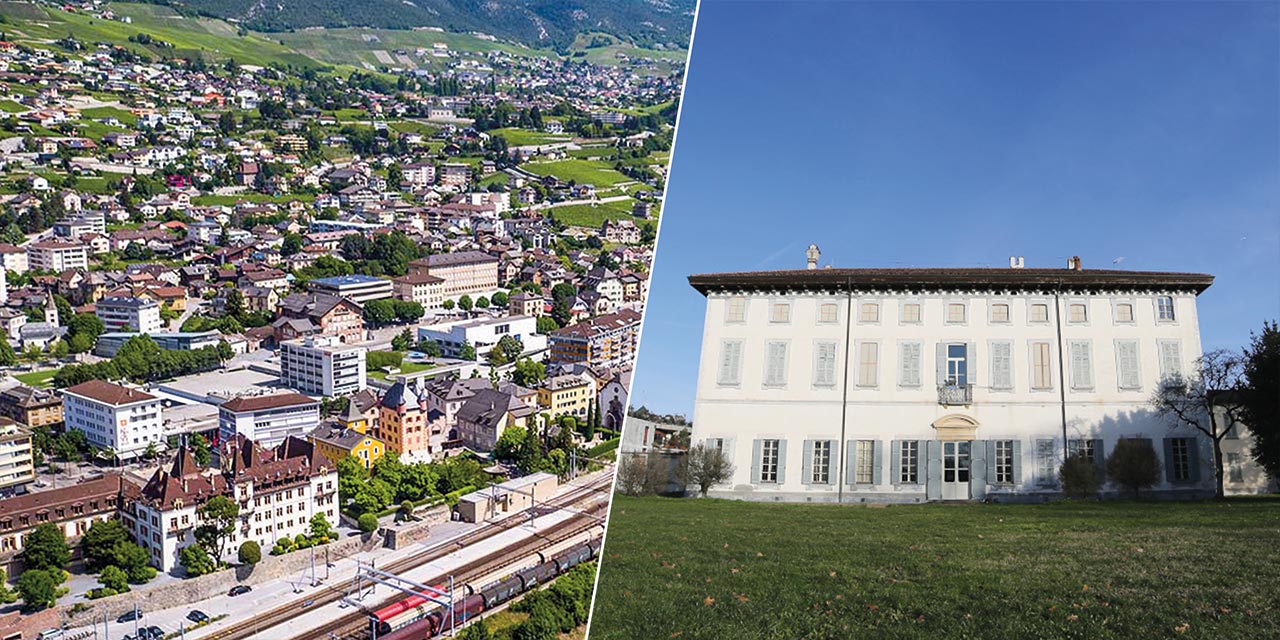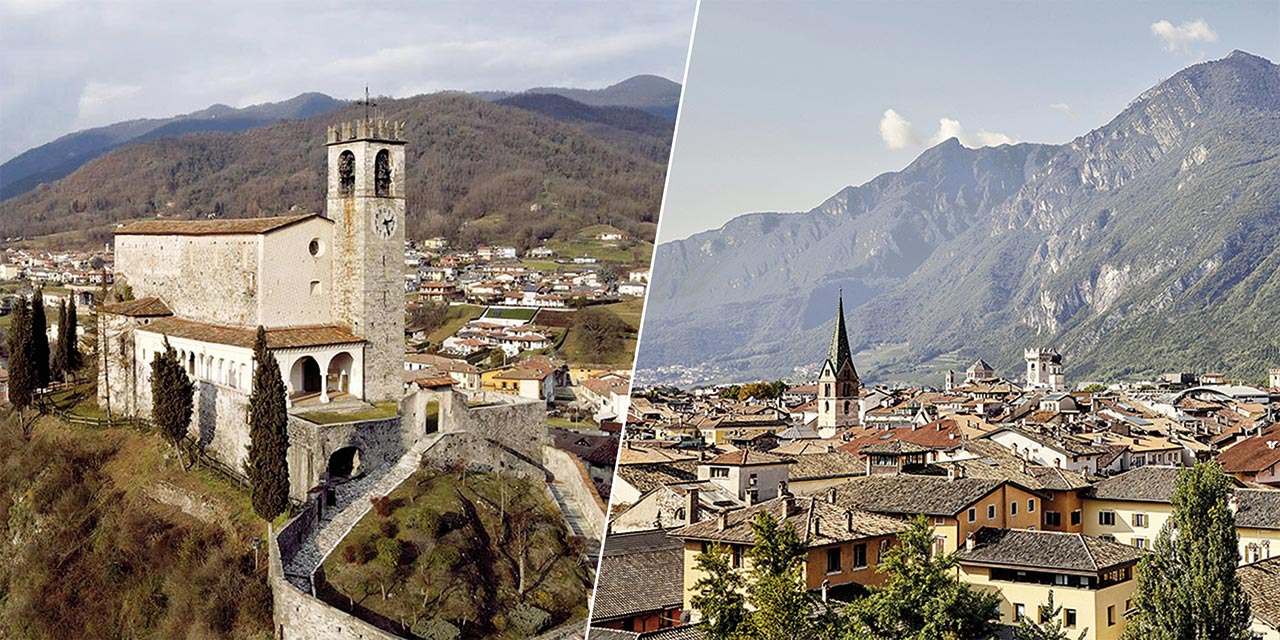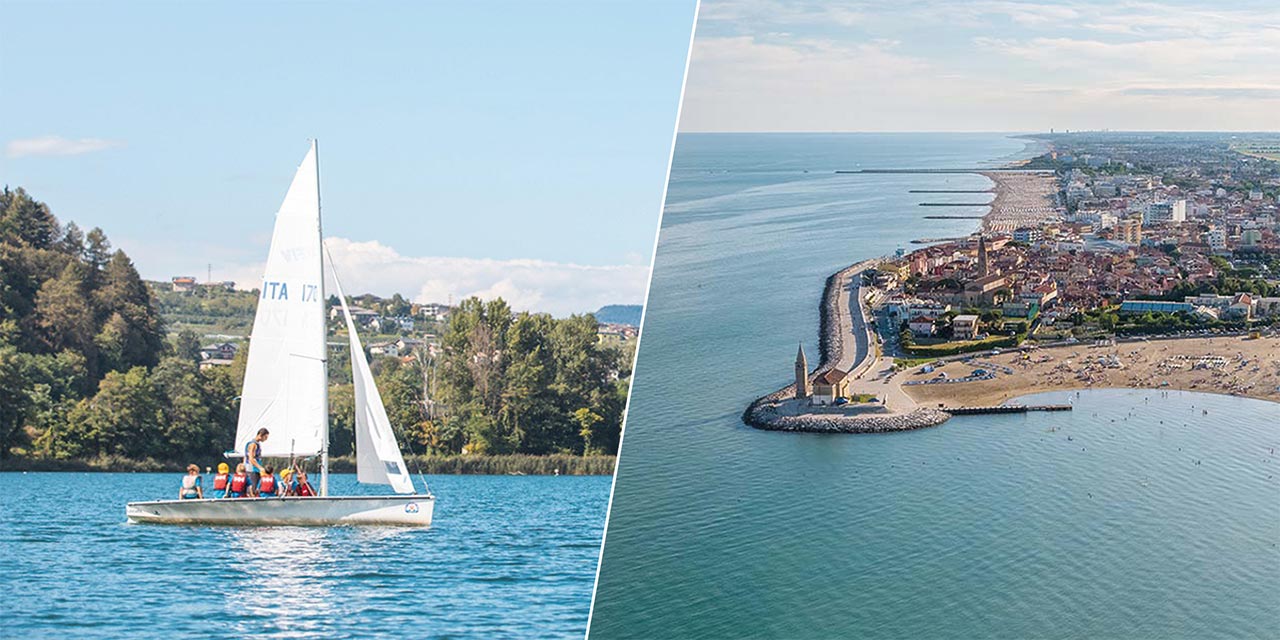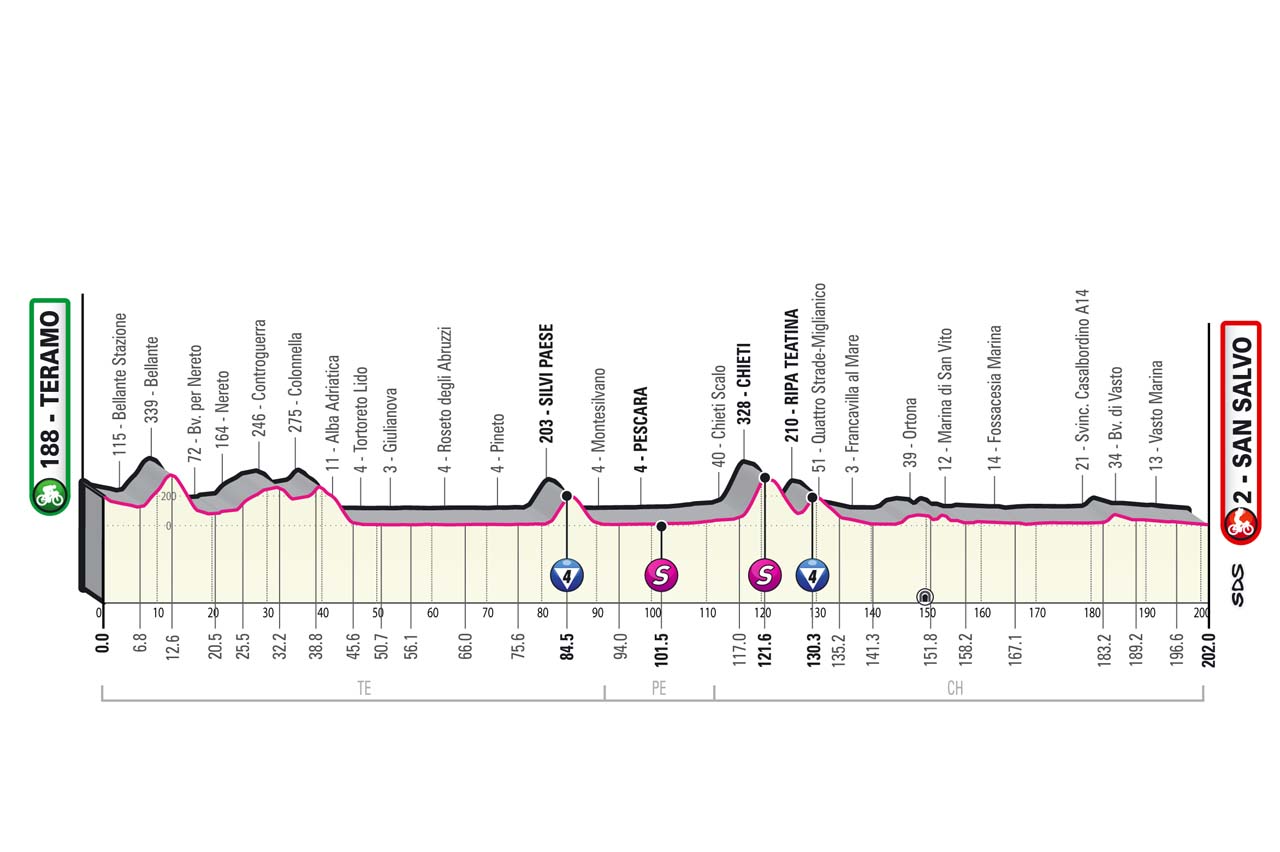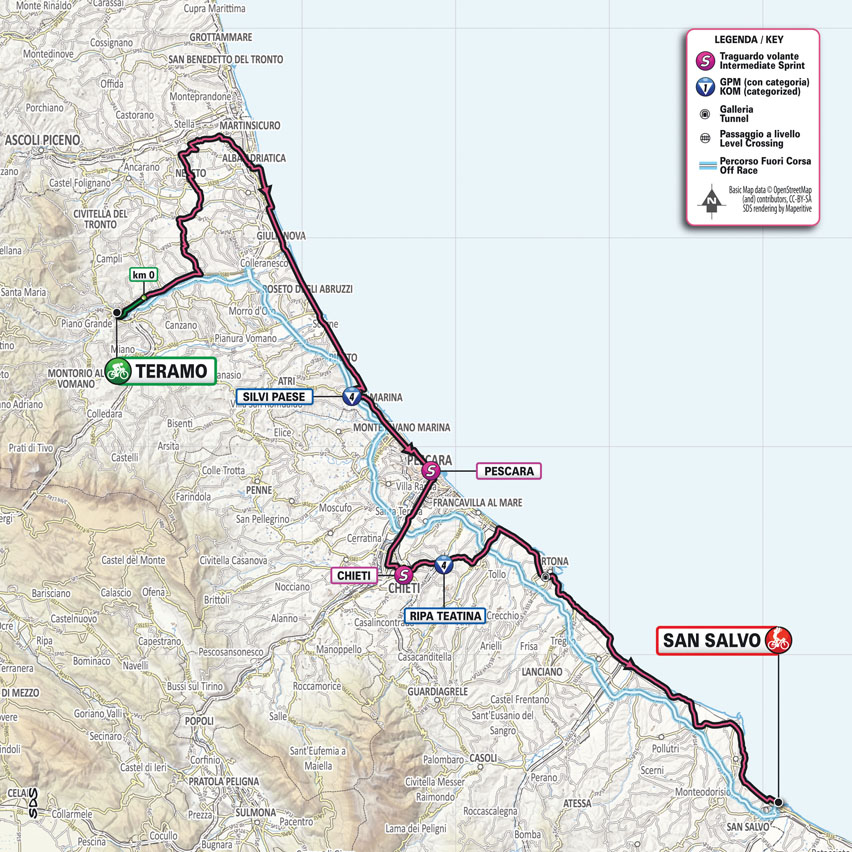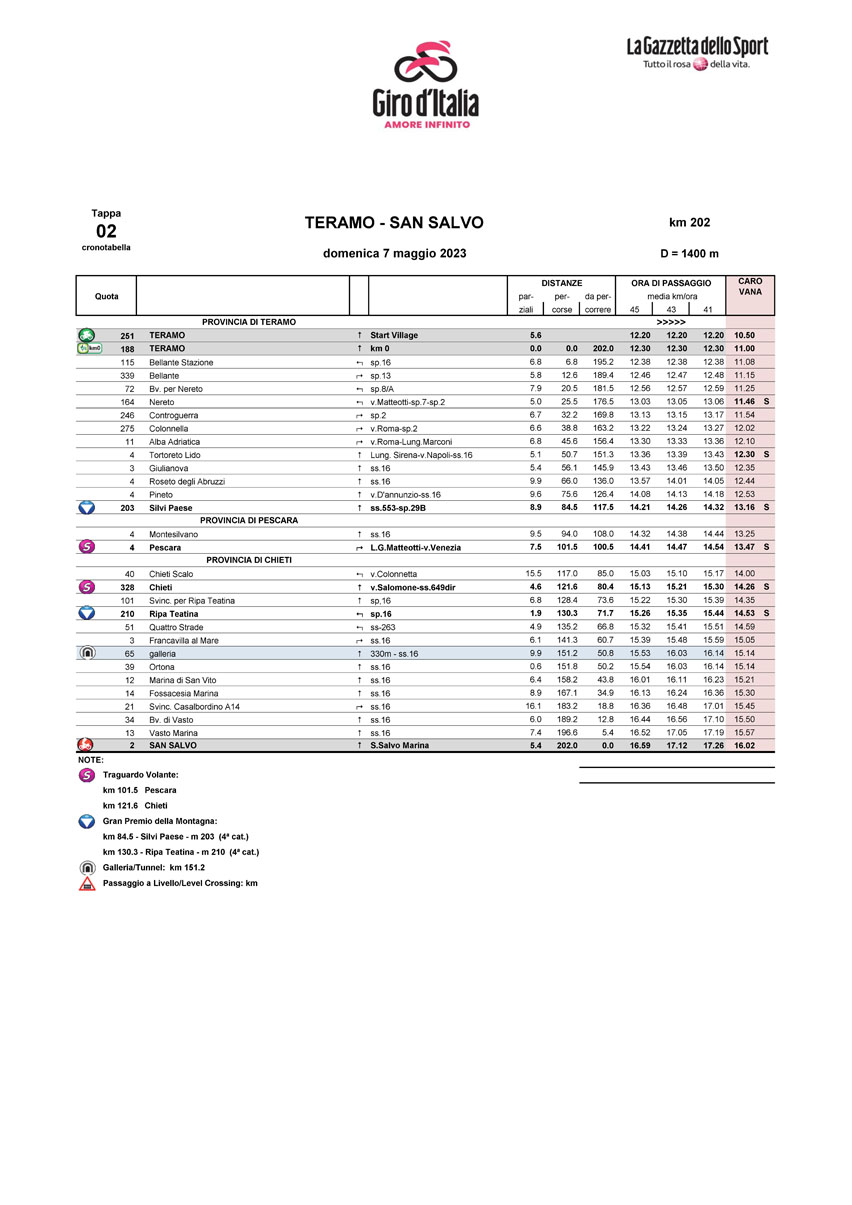profile
map
technical info
The route
The stage alternates between flat drags along the coast and hilly stretches in the hinterland. The route takes in a few mild ascents (Bellante, Controguerra and Colonnella) and then follows the Statale Adriatica all the way to Silvi Paese, with KOM points up for grabs at the summit of a 4 km climb. The route passes Pescara (along the coast) and takes in climbs to Chieti and then Ripa Teatina (KOM). After reaching the seafront again, the stage continues along the coast all the way to the finish in San Salvo. The seaside roads are wide and with a few bends, while the inland roads are narrower, wavy and curving.
Final kilometres
The final kilometres are essentially straight and perfectly flat, with roundabouts, traffic dividers and pedestrian islands being the common impediments. A roundabout 1,400 m before the finish, to be taken following the flow of traffic, leads into the last bend, 1 km from the line. The home straight (1,000 m) is on 8 m wide tarmac.
start / finish
final kilometres
itinerary timetable
tourist info
Host city:
Teramo
Overview
The city of Teramo is one of the four provincial capitals of the Abruzzo region. It is located at the confluence of the Tordino river and the Vezzola stream, on the slopes of the Gran Sasso and a few minutes from the Adriatic Sea, an ideal position to easily visit the characteristic Teramo area.
Founded at the time of the Phoenicians, it was submitted to the Romans who gave it the name of Interamnia Urbs, which means “city between the two rivers”. It was during the rule of the emperors Augustus, first, and Hadrian, then, that the city experienced a flourishing period, witnessed by the presence of numerous monuments, temples, theaters, amphitheaters, and baths still partially visible and visitable.
During the Middle Ages, the city experienced a second moment of splendor, despite the bitter struggles between the two dynasties, Angevin and Aragonese.
In the eighteenth and nineteenth centuries Teramo had an intense cultural life, opening to the ideas of the Enlightenment of illustrious scholars, such as Melchiorre Delfico, to whom it gave birth.
Food
An incredible territory where nothing is missing, with products that come from the sea, hills and mountains such as Gran Sasso or Monte Piselli. It could only have a very rich traditional cuisine. Over 250 traditional dishes with a main dish – Le Virtù – that alone contains more than 50 ingredients.
Teramo cuisine has an immense variety of dishes: ranging from fish classics to meat traditions, up to many vegetables and fresh pasta, especially egg and strictly handmade pasta. Among these there is the Chitarra con le pallottine alla Teramana, a pasta prepared with the guitar, a special rectangular wooden frame, seasoned with meatballs.
Another elegant dish are the Scrippelle ‘mbusse teramane. In the dialect the word ‘mbusse means “soaked” precisely because the scrippelle (very thin crepes made with water, flour and eggs) are wet with a rich and tasty meat broth that make them soft and tasty. And then, very common in Abruzzo, are the arrosticini, strictly made with sheep meat.
Le virtu’
The virtues are a super-rich soup of the first fruits of the season, expertly mixed with all the remains of the winter pantry and which is consumed on the first of May in Teramo. April 30 was considered by the peasant calendar to be the watershed between the end of winter and the beginning of the fertile season. Legend has it that the virtues are so called because they had to be prepared from 7 virgins, using 7 legumes, 7 aromas, 7 meats, 7 seasonal vegetables, 7 types of pasta, cooked all in 7 hours … 7, because there are 7 Christian virtues. In short, the virtues are a truly exceptional dish, normally to prepare it takes 7 to 10 days. In truth, for virtues we need over 50 ingredients, each family guards and jealously passes on its version of the recipe. To preserve the authenticity of the recipe, a group of experts and restaurateurs from Teramo have created a specification, also recognized by the Ministry of the Environment and Forest Policies. If you have never tasted them, the time has come, available from the first of May until mid-month, the Virtues will steal your heart combined with an excellent Cerasuolo d’Abruzzo.
Wine and beverage
Speaking of Teramo wine, we cannot fail to mention the Consorzio Colline Teramane which protects the wineproduced by the homonymous Montepulciano vine, one of the two DOCG wines of the Abruzzo region. It is an extraordinary wine, intense ruby red in color with slight purple hues, characteristic, ethereal, intense aroma; the taste is dry, full, robust but harmonious and velvety, the hints are those of ripe red fruit and spices.
Points of Interest
Cathedral of Santa Maria Assunta
It is the greatest historical monument of the city built, after the destruction of the Ancient Cathedral, between the thirteenth and fourteenth centuries. In Romanesque-Gothic style, the Cathedral has a unique doorway between the twentieth century with Cosmatesque mosaics and sculptures attributed to Nicola da Guardiagrele. The interior has three naves with columns of reuse from the Roman era. Worth noticing is the Baroque Chapel of San Berardo inside which is located the Polyptych of Jacobello del Fiore (XIV century). On the main altar valuable frontal in embossed silver by Nicola da Guardiagrele (early fifteenth century).
Roman Theatre
The most representative public monument of the Roman City of Interamnia Praetutiorm. It is one of the oldest public buildings for performances (theatrical, but not only) in the Roman world. It was built in the very early imperial era and could hold about 2,600 spectators comfortably seated. The exterior is characterized by an architecture with large blocks, opus quadratum, of three superimposed orders (Doric, Ionic, Corinthian) with a porticus towards the City.
Castle Della Monica
Inserted within a small village in neo-Gothic style, the Castle appears as an authentic and wellpreserved medieval building, but, it is not so. The Castello Della Monica bears the name of its creator, builder and owner Gennaro Della Monica, painter from Teramo, born in 1836 and died in 1917 and is the heart of the artist’s project, here we see expressed all the passion for art, creativity and his imagination, he conceived all the solutions and details, structural and decorative, interior and exterior, from the paintings on the wall to the design of the garden, to the insertion of archaeological finds and authentic fragments.
Melatino Palace
Original stately building dating back to the thirteenth century belonged to the De Melatino family and today is home to the Tercas Foundation. The building is spread over three floors and is characterized, at the Rhine plant, by cross vaults and remains of an ancient portico with masonry columns, which support ogive arches. From the entrances of the façade on the street, following the renovation of the Palace, you enter a space full of testimonies in which it is possible to read the successive stratifications: the double layer of the floors of a Roman domus, both of refined workmanship, mosaic the one and sectile the second, superimposed on the first.
Civic Art Gallery
Established in 1870, today preserves a considerable heritage of fourteenth century and fifteenth century wall paintings, coming from the churches and convents of Teramo, the place of honor belongs to the polyptych of Giacomo da Campli. In the current exhibition there are also three works by authors from the sixteenth to the twentieth century: Ribera, Preti, Giordano, De Mura, Solimena, Giaquinto, Conca, Gennaro Della Monica, Raffaello Pagliaccetti, Pasquale Celommi, Cesare Averardi, Giovanni Melarangelo, Venanzo Crocetti and Guido Montauti.
San Salvo
Overview
Due to its natural disposition, the city of San Salvo was for centuries the south-eastern gate of Abruzzo. It is a city of 19,963 inhabitants located at 100 m. above sea level and 4 km from the Adriatic, on whose shores there is a very fine Sandy beach. San Salvo embodies different vocations. It is a city of the sea and summer holidays under its Blue Flag banner.
It is a riverside city with the Trigno river and its botanical and natural treasures. It is an agricultural city surrounded by olive trees and covered with crops .It is a city of travel, with ancient and modern routes: from the tratturo to the cycle path, from the motorway to the valley , from the fast railway to glorious national road.
Surprisingly, it is also a city of history. The historical story of San Salvo is, in fact, millenary, closely linked to the geographical position. After prehistory, its territory has known the Apennine civilization, woven relationships with Mycenaean and Greek world (II/I millennium BC) and saw the affirmation of italic civilization (6th-3rd century BC). With the romanization of Frentania (3rd-1st century BC), a city with rich domus was built on the current urban site, underground aqueduct and thermal baths, with a port at the mouth of the Trigno active in the trade (1st century BC-3rd century AD) with the whole Mediterranean.
The early Middle Ages was characterized by the establishment of two Benedictine monasteries: Sant’Angelo in Salavento and Santo Salvo (eponym of the town); the Late Middle Ages for that of the Cistercian abbey of San Vito del Trigno (13th century), in the homonymous river plain.
The 19th and early 20th centuries produced a slow but steady economic recovery (based on agriculture and handicrafts) and demographic which found the its climax in the phase of intense development of the forty years 1961-2000.
After the great peasant struggles (1950), the industrial settlements of the S.I.V. (1963, then Pilkington) and Magneti Marelli (1973, then Denso) together with the development related industries, commerce, tourism and services allowed a new, intense urbanization process allowing San Salvo to become the fastest growing city in population in Abruzzo. The city of San Salvo has always stood out for the industriousness and dynamism of its people. In the last decade excavations and archaeological discoveries have given new vigor to this impetus through the discovery of a previous historical identity unknown. All this has enriched an already rich and articulated tourist offer, made of nature, history, archeology, food and wine, sea, leisure and nautical pleasure.
Food
San Salvo’s territory is rich in genuine products, that are the result of a millennium old heritage of rural and country knowledge, enriched during the Middle Ages by thwith a huge varie great rural Cistercian tradition brought in this area by the monks of the SS Vito’s and Salvo’s Abbey. Among the many local products the olive stands out; its fruits are picked up before the full ripeness and processed in the same day, so that it gives the olive oil a fruity aroma, limpidness and a low rate of acidity.
The peach cultivation has a great importance in San Salvo and this fruit is exported in all Europe.
San Salvo boasts an high level food tradition with a huge variety of home made pasta, sweets, and sausage products like sausages, pepperoni, “soppressate”, “capicolli” and “ventricine”: these products are often home made, but in the last years their manufacturing production has a great success.
Drink
The wine production has its excellences in some IGP wines such as the “Chardonnay della Provincia di Chieti”, the “Pecorino d’Abruzzo”, the “Sangiovese” and the “Trebbiano d’Abruzzo”; some DOC red wines such as the “Cerasuolo” and the “Montepulciano d’Abruzzo”, Cerasuolo d’Abruzzo.
Liqueurs: Flavored cooked must, Limoncello
Points of Interest
The Quadrilateral Archaeological Park is situated in the historical center of San Salvo. It corresponds to the original foundation of the town and it is part of a cultural heritage system for the benefit of the audience.
Founded after archaeological researches carried out in 1997, situated in the area around “Piazza San Vitale”, the Park is made of seven archaeological-historical sites. It promotes the knowledge of its historical-archaeological heritage and organizes activities about cultural patrimony in general. Besides the exhibition area, monuments and archaeological sites there are suitable spaces to house meetings, conferences, debates, concerts, artistic laboratories and didactical activities.
The Civic Museum “Porta della Terra” 2 collects and displays some of the archaeological findings coming from the territory of San Salvo, and especially from the Quadrilater Area. The objects exhibited have been selected according to an underground route that goes backwards in time from the Middle Ages to the Archaic Age (6th century BC) passing through rooms with Medieval and Roman walls.
The excavations allowed us to reconstruct the different building phases of the Cistercian monastic settlement during the Middle Ages, when the Quadrilateral area reached its definitive shape, still recognizable in the urban area of the historical centre of San Salvo; this occurred exactly during the construction of the SS Vito’s and Salvo’s Cistercian Abbey, which at the end of the 13th century reorganized a Benedictine community present in the area at least since 1173.
The archaeological investigations have brought to light also the ruins of a Roman settlement, built in the first century AD, which reached its greatest development in the 3rd century AD. To this period belongs the Roman Hypogeum Aqueduct – still feeding the “Fontana Vecchia” (Old Fountain) – and a huge and composite building with masonry in opus incertum, mosaic pavements, marble polychrome revetments and plaster painted in fresco.
In the last section of the Museum are exposed the funerary equipments B from a necropolis belonging to the Archaic Age, discovered in “Via Galilei”, nearby the stadium.
They represent precious informations about the stable occupation of the river terrace, on which San Salvo rises at least since 6th century BC, when the site, that dominates an extensive portion of the low valley of the Trigno river, had been chosen by Frentani population for its strategic position and fertility of its soils.
The Abbey Museum 3 collects findings and documents about the presence of Benedictine monks in South Abruzzi, with particular attention to SS Vito’s and Salvo’s Cistercian Abbey.
The Museum offers a thorough analysis on some questions about the millenarian history of the Benedictine Order. The lucky discovery of various fragments of earthenware has allowed to recall the refectory of the monks of SS. Vito’s and Salvo’s Abbey at the beginning of the 14th century, with a true reproduction of the tableware in use at that period.
In the Museum there is a photographic copy of the Chronicon Casauriense, the most important source for the Medieval history of the Abruzzi, written around 1140 in the scriptorium of St. Clemente in Casauria’s Benedectine Abbey.
In the Cloister Archaeological Site 4 there are ruins belonging to a Roman domus and the platform in concrete of a monumental well situated in the centre of the Abbey cloister.
During the Middle Ages St. Joseph church has been the church of the Benedictine monastery of San Salvo (XII century) and then the church of SS Vito’s and Salvo’s Cistercian Abbey (late 13th century) till the 15th century, when the monks decided to leave the settlement. From then on numerous re-adaptations have modified the original aspect, but the northern outer wall still preserves the Medieval masonry with two single lancet windows in limestone, which have been walled in Modern Age.
The Roman Mosaic Archeological Site 6 dues its name to the remarkable polychrome tessellated paving found in 2002.
The northern part of the mosaic forms a carpet consisting in a frame with vine branches which come out from four elegant cantharus, and a central field containing the emblema, which unfortunately has been destroyed.
The southern part of the mosaic is made of carpets with geometric subjects, some of these alternate colours according to modular schemes.
The Town Park 8 is the pre-eminently meeting place of the local community. In this place social relations are made up,
children and tourists feel welcome thanks to the playground, the bycicle path, the facilities area and suggestive sculptures recently made and exposed in the park.
The fountain “Forze Emergenti” (Emerging Strength), better known as “Fontana di Vetro” (Glass Fontain), is an architectonic sculpture composed by four basins surmounted by an elaborate geometrical composition of glass sculptured elements.
The Fountain is a real open-air museum; it can be crossed by the visitor and it represents the phases of glass production process, an activity that is the basis of the social and economic transformation of the local community from the 60s till now.
The dynamic composition of “L’Aquilone” (The Kite) concludes the message of the Fountain, underlining the aim aspects linked to the future towards that the town feels projected. The “A. Moro” Cultural Centre 9 houses the town’s library, the auditorium, the theatre and cinema hall mand a recording studio designed by the architect Giovanni Di Domenico.
The “Cristoforo Colombo” waterfront promenade is about 2,5 km long and it is the ideal place for relaxing walk, caressed by the pleasant and scented sea breeze. There are also many opportunities to make interesting excursions without going too far from the holiday resort.
The marina, opened in 2008 to answer to the increasing demand of the local yachting marine, is active throughout the year. It offers high level facilities that attract an ever-growing number of tourists.
In addition to relax, amusement and entertainment, San Salvo’s beach offers the chance to discover important natural habitats that are nowadays protected by the Mediterranean Botanical Garden for their rich and characteristic spontaneous coast vegetation.
The ancient stretch of the “Regio Tratturo L’Aquila-Foggia” (royal sheep-track) was used for thousands of years by shepherds and their flocks during their seasonal movings between the Abruzzi mountains and the Apulia plains; today it is crossed by a beautiful Bicycle Path 10 with pine trees all along, which goes from San Salvo Marina to other bicycle paths of the nearby towns.
The marina “Le Marinelle” 11 is situated in the southern end of San Salvo Marina. It is a modern structure with a capacity of two hundred boats as long as twenty meters of length and it offers a restaurant, accommodation and boat rental services. Leaving the harbor it is possible to make interesting excursions sailing along the Teatina Coast National Park toward North.
From the sea it is possible to admire the ample equipped sandy beach, the Botanical Garden, long stretches of the sandy shore with the typical dunes, Vasto beach and the following extraordinary cliffs with its composition of promontories and inlets. Rounding Punta Penna Cape we find ourselves inside the Punta Aderci Natural Regional Reserve, with its suggestive beach rich in dunes and the stones beaches framed by the luxuriant Mediterranean spontaneous vegetation.
The marina is situated in a strategic position also for excursions in other directions: it is 10 nm far from Termoli, 25 nm far from Lesina, 30 nm far from the Tremiti Islands Archipelago, 50 nm far from Rodi Garganico, 55 nm far from Peschici, 70 to 100 nm far from the main tourist resorts of Croatia.
The Mediterranean Botanical Garden 12 protects and enhances a large area of sand dunes and ponds between the beach and the “Regio Tratturo L’Aquila-Foggia” (the ancient Royal sheep-track L’Aquila-Foggia). Visiting it means to discover how sandy beaches along the Adriatic Coast were until a few decades ago, before the beginning of the mass seaside tourism.
It is the result of a “restauration” work inspired to rigorous scientific criteria, one of the rare Italian dune gardens, none the less the only one in the whole Adriatic Coast which preserves botanical species elsewhere extinct.
Instead, the back-dune habitat houses vegetation of the humid pond habitat that attracts lots of amphibian species, fresh water turtles and birds, like the stilt bird, the sandpiper, the night heron, the little bittern, the redshank. There is also a Mediterranean scrub habitat with the tipical evergreen bushes (juniper, rosemary, laurel), tall ilexes and pine trees. The Garden allows the visitor to know the peculiarities of this habitat also by organizing specific activities. It also houses the Sea Observatory, the Didactic Pool, a research, recovery and first aid centre for sea turtles and tortoises.

